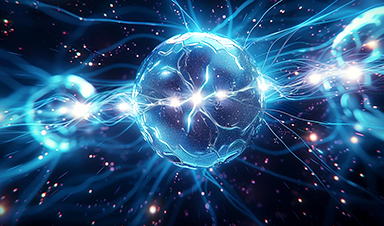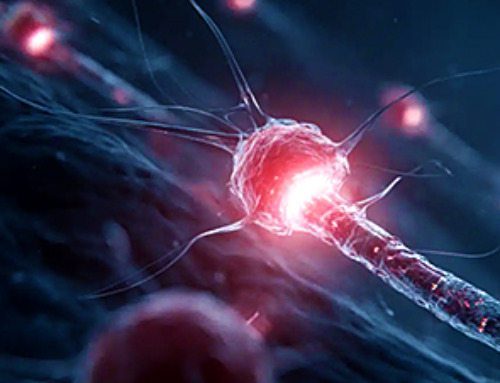MIT physicists surprised to discover electrons in pentalayer graphene can exhibit fractional charge.
New theoretical research from MIT physicists explains how it could work, suggesting that electron interactions in confined two-dimensional spaces lead to novel quantum states, independent of magnetic fields.
Groundbreaking Discovery in Graphene
MIT physicists have made significant progress in understanding how electrons can split into fractional charges. Their findings reveal the conditions that create exotic electronic states in graphene and other two-dimensional materials.
This new research builds on a recent discovery by another MIT team led by Assistant Professor Long Ju. Ju’s group observed that electrons seem to carry “fractional charges” in pentalayer graphene—a structure made of five stacked graphene layers placed on a similar sheet of boron nitride.
Unveiling Fractional Charges
Ju discovered that when he sent an electric current through the pentalayer structure, the electrons seemed to pass through as fractions of their total charge, even in the absence of a magnetic field. Scientists had already shown that electrons can split into fractions under a very strong magnetic field, in what is known as the fractional quantum Hall effect. Ju’s work was the first to find that this effect was possible in graphene without a magnetic field — which until recently was not expected to exhibit such an effect.
The phenemonon was coined the “fractional quantum anomalous Hall effect,” and theorists have been keen to find an explanation for how fractional charge can emerge from pentalayer graphene.
Theoretical Advances and Collaboration
The new study, led by MIT professor of physics Senthil Todadri, provides a crucial piece of the answer. Through calculations of quantum mechanical interactions, he and his colleagues show that the electrons form a sort of crystal structure, the properties of which are ideal for fractions of electrons to emerge.
“This is a completely new mechanism, meaning in the decades-long history, people have never had a system go toward these kinds of fractional electron phenomena,” Todadri says. “It’s really exciting because it makes possible all kinds of new experiments that previously one could only dream about.”
The team’s study was published recently in the journal Physical Review Letters. Two other research teams — one from Johns Hopkins University, and the other from Harvard University, the University of California at Berkeley, and Lawrence Berkeley National Laboratory — have each published similar results in the same issue. The MIT team includes Zhihuan Dong PhD ’24 and former postdoc Adarsh Patri.
“Fractional Phenomena”
In 2018, MIT professor of physics Pablo Jarillo-Herrero and his colleagues were the first to observe that new electronic behavior could emerge from stacking and twisting two sheets of graphene. Each layer of graphene is as thin as a single atom and structured in a chicken-wire lattice of hexagonal carbon atoms. By stacking two sheets at a very specific angle to each other, he found that the resulting interference, or moiré pattern, induced unexpected phenomena such as both superconducting and insulating properties in the same material. This “magic-angle graphene,” as it was soon coined, ignited a new field known as twistronics, the study of electronic behavior in twisted, two-dimensional materials.
“Shortly after his experiments, we realized these moiré systems would be ideal platforms in general to find the kinds of conditions that enable these fractional electron phases to emerge,” says Todadri, who collaborated with Jarillo-Herrero on a study that same year to show that, in theory, such twisted systems could exhibit fractional charge without a magnetic field. “We were advocating these as the best systems to look for these kinds of fractional phenomena,” he says.
Surprising Experimental Results
Then, in September of 2023, Todadri hopped on a Zoom call with Ju, who was familiar with Todari’s theoretical work and had kept in touch with him through Ju’s own experimental work.
“He called me on a Saturday and showed me the data in which he saw these [electron] fractions in pentalayer graphene,” Todadri recalls. “And that was a big surprise because it didn’t play out the way we thought.”
In his 2018 paper, Todadri predicted that fractional charge should emerge from a precursor phase characterized by a particular twisting of the electron wavefunction. Broadly speaking, he theorized that an electron’s quantum properties should have a certain twisting, or degree to which it can be manipulated without changing its inherent structure. This winding, he predicted, should increase with the number of graphene layers added to a given moiré structure.
“For pentalayer graphene, we thought the wavefunction would wind around five times, and that would be a precursor for electron fractions,” Todadri says. “But he did his experiments and discovered that it does wind around, but only once. That then raised this big question: How should we think about whatever we are seeing?”
Rethinking Electron Interactions
In their new study, Todadri and his team revisited how electron fractions could form in pentalayer graphene after their initial prediction fell short. Upon reviewing their original hypothesis, they discovered they might have overlooked a crucial factor.
“The standard strategy in the field when figuring out what’s happening in any electronic system is to treat electrons as independent actors, and from that, figure out their topology, or winding,” Todadri explains. “But from Long’s experiments, we knew this approximation must be incorrect.”
While in most materials, electrons have plenty of space to repel each other and zing about as independent agents, the particles are much more confined in two-dimensional structures such as pentalayer graphene. In such tight quarters, the team realized that electrons should also be forced to interact, behaving according to their quantum correlations in addition to their natural repulsion. When the physicists added interelectron interactions to their theory, they found it correctly predicted the winding that Ju observed for pentalayer graphene.
Once they had a theoretical prediction that matched with observations, the team could work from this prediction to identify a mechanism by which pentalayer graphene gave rise to fractional charge.
They found that the moiré arrangement of pentalayer graphene, in which each lattice-like layer of carbon atoms is arranged atop the other and on top of the boron-nitride, induces a weak electrical potential. When electrons pass through this potential, they form a sort of crystal, or a periodic formation, that confines the electrons and forces them to interact through their quantum correlations. This electron tug-of-war creates a sort of cloud of possible physical states for each electron, which interacts with every other electron cloud in the crystal, in a wavefunction, or a pattern of quantum correlations, that gives the winding that should set the stage for electrons to split into fractions of themselves.
“This crystal has a whole set of unusual properties that are different from ordinary crystals, and leads to many fascinating questions for future research,” Todadri says. “For the short term, this mechanism provides the theoretical foundation for understanding the observations of fractions of electrons in pentalayer graphene and for predicting other systems with similar physics.”
Reference: “Theory of Quantum Anomalous Hall Phases in Pentalayer Rhombohedral Graphene Moiré Structures” by Zhihuan Dong, Adarsh S. Patri and T. Senthil, 12 November 2024, Physical Review Letters.
DOI: 10.1103/PhysRevLett.133.206502
This work was supported, in part, by the National Science Foundation and the Simons Foundation.
News
Drug-Coated Neural Implants Reduce Immune Rejection
Summary: A new study shows that coating neural prosthetic implants with the anti-inflammatory drug dexamethasone helps reduce the body’s immune response and scar tissue formation. This strategy enhances the long-term performance and stability of electrodes [...]
Scientists discover cancer-fighting bacteria that ‘soak up’ forever chemicals in the body
A family of healthy bacteria may help 'soak up' toxic forever chemicals in the body, warding off their cancerous effects. Forever chemicals, also known as PFAS (per- and polyfluoroalkyl substances), are toxic chemicals that [...]
Johns Hopkins Researchers Uncover a New Way To Kill Cancer Cells
A new study reveals that blocking ribosomal RNA production rewires cancer cell behavior and could help treat genetically unstable tumors. Researchers at the Johns Hopkins Kimmel Cancer Center and the Department of Radiation Oncology and Molecular [...]
AI matches doctors in mapping lung tumors for radiation therapy
In radiation therapy, precision can save lives. Oncologists must carefully map the size and location of a tumor before delivering high-dose radiation to destroy cancer cells while sparing healthy tissue. But this process, called [...]
Scientists Finally “See” Key Protein That Controls Inflammation
Researchers used advanced microscopy to uncover important protein structures. For the first time, two important protein structures in the human body are being visualized, thanks in part to cutting-edge technology at the University of [...]
AI tool detects 9 types of dementia from a single brain scan
Mayo Clinic researchers have developed a new artificial intelligence (AI) tool that helps clinicians identify brain activity patterns linked to nine types of dementia, including Alzheimer's disease, using a single, widely available scan—a transformative [...]
Is plastic packaging putting more than just food on your plate?
New research reveals that common food packaging and utensils can shed microscopic plastics into our food, prompting urgent calls for stricter testing and updated regulations to protect public health. Beyond microplastics: The analysis intentionally [...]
Aging Spreads Through the Bloodstream
Summary: New research reveals that aging isn’t just a local cellular process—it can spread throughout the body via the bloodstream. A redox-sensitive protein called ReHMGB1, secreted by senescent cells, was found to trigger aging features [...]
AI and nanomedicine find rare biomarkers for prostrate cancer and atherosclerosis
Imagine a stadium packed with 75,000 fans, all wearing green and white jerseys—except one person in a solid green shirt. Finding that person would be tough. That's how hard it is for scientists to [...]
Are Pesticides Breeding the Next Pandemic? Experts Warn of Fungal Superbugs
Fungicides used in agriculture have been linked to an increase in resistance to antifungal drugs in both humans and animals. Fungal infections are on the rise, and two UC Davis infectious disease experts, Dr. George Thompson [...]
Scientists Crack the 500-Million-Year-Old Code That Controls Your Immune System
A collaborative team from Penn Medicine and Penn Engineering has uncovered the mathematical principles behind a 500-million-year-old protein network that determines whether foreign materials are recognized as friend or foe. How does your body [...]
Team discovers how tiny parts of cells stay organized, new insights for blocking cancer growth
A team of international researchers led by scientists at City of Hope provides the most thorough account yet of an elusive target for cancer treatment. Published in Science Advances, the study suggests a complex signaling [...]
Nanomaterials in Ophthalmology: A Review
Eye diseases are becoming more common. In 2020, over 250 million people had mild vision problems, and 295 million experienced moderate to severe ocular conditions. In response, researchers are turning to nanotechnology and nanomaterials—tools that are transforming [...]
Natural Plant Extract Removes up to 90% of Microplastics From Water
Researchers found that natural polymers derived from okra and fenugreek are highly effective at removing microplastics from water. The same sticky substances that make okra slimy and give fenugreek its gel-like texture could help [...]
Instant coffee may damage your eyes, genetic study finds
A new genetic study shows that just one extra cup of instant coffee a day could significantly increase your risk of developing dry AMD, shedding fresh light on how our daily beverage choices may [...]
Nanoneedle patch offers painless alternative to traditional cancer biopsies
A patch containing tens of millions of microscopic nanoneedles could soon replace traditional biopsies, scientists have found. The patch offers a painless and less invasive alternative for millions of patients worldwide who undergo biopsies [...]





















